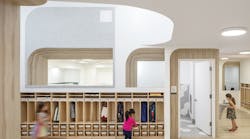The Superstore will serve as a test site to determine the viability of expanding LED parking lot lights at Wal-Mart stores nationwide.
Wal-Mart is one of 43 retailers that are actively engaged in DOE's Net-Zero Energy Commercial Building Initiative (CBI) as members of the DOE Retailer Energy Alliance (REA).
REA members work with DOE and the national laboratories to advance the development and market adoption of net-zero energy commercial buildings. The alliance has attracted large and small retailers who are committed to reducing the energy costs, greenhouse gas emissions, and overall operating risks of retail businesses. The primary aim of DOE's energy alliances is to create specifications for promising energy efficiency technologies, test their viability in order to encourage use, and drive down costs.
The specifications for the LED lighting were sponsored by DOE and were developed by Pacific Northwest National Laboratory (PNNL) and retailers nationwide to address energy-efficient lighting opportunities. DOE's Solid-State Lighting Program provided technical assistance.
LED parking lot lighting offers potentially enormous energy savings, in part because the lights are more precise in their direction, reducing waste light and limiting glare. DOE and its national laboratories predict that LED parking lot lights will reduce parking lot energy needs by more than 50% and maintenance costs by more than 80% compared to traditional parking lot lights. For retailer sites that are open 24 hours a day, traditional lights must be replaced every two years; LED lights will be replaced every 10 years on average.
Round 8 of CALiPER testing – summary results
The U.S. Department of Energy (DOE) has completed Round 8 of product testing through the its Solid-State Lighting (SSL) CALiPER program. A Summary Report containing the results from Round 8 testing is now available for download on the DOE SSL website at www.ssl.energy.gov/reports.html.
Round 8 of product testing focused primarily on replacement lamps, including MR16 lamps, PAR lamps, and small omni-directional replacement lamps. Benchmark replacement lamps using incandescent, halogen, and CFL light sources were also tested in each application category for comparison to SSL. Additional products tested included three undercabinet products, a downlight, and an outdoor streetlight.
The Department allows detailed test results from CALiPER testing to be distributed in the public interest for noncommercial, educational purposes only. Detailed test reports for Round 8 will be available soon through the searchable on-line CALiPER system at www.ssl.energy.gov/search.html.
In response to stakeholder feedback, DOE has enhanced the CALiPER system with an advanced search capability that allows users to more easily view and compare test results. Round 8 detailed test reports will be available in the coming weeks.




